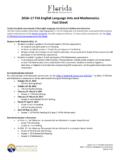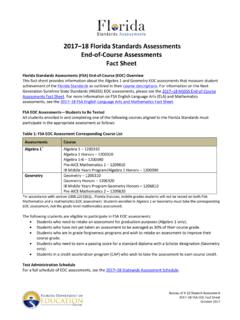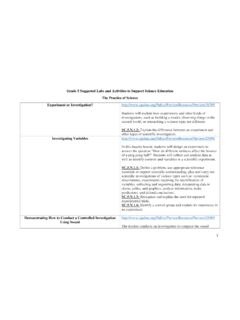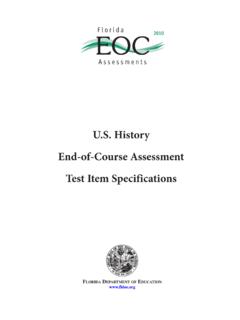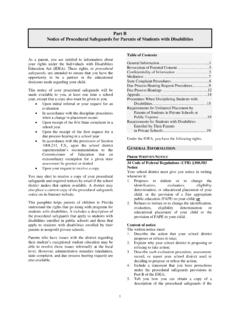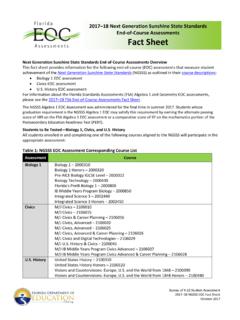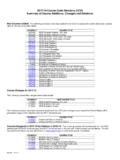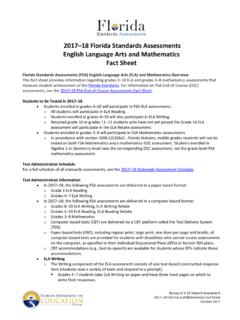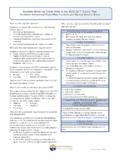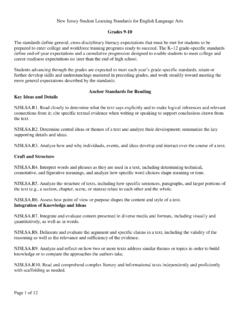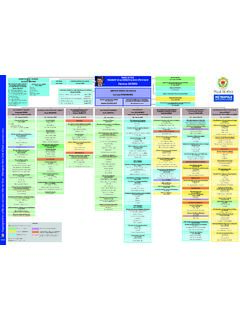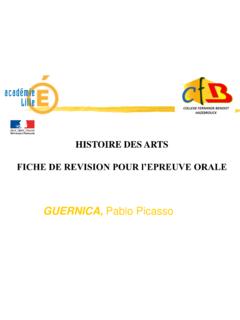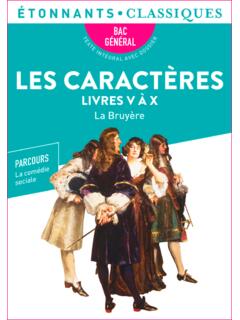Transcription of Language Arts Florida Standards (LAFS) Grades 9 & 10
1 Language arts Florida Standards ( lafs ). Grades 9 & 10. Strand: READING Standards FOR LITERATURE. Cluster 1: Key Ideas and Details STANDARD CODE STANDARD. Cite strong and thorough textual evidence to support analysis of what the text says explicitly as well as inferences drawn from the text. Cognitive Complexity: Level 2: Basic Application of Skills & Concepts Determine a theme or central idea of a text and analyze in detail its development over the course of the text, including how it emerges and is shaped and refined by specific details; provide an objective summary of the text.
2 Cognitive Complexity: Level 3: Strategic Thinking & Complex Reasoning Analyze how complex characters ( , those with multiple or conflicting motivations) develop over the course of a text, interact with other characters, and advance the plot or develop the theme. Cognitive Complexity: Level 3: Strategic Thinking & Complex Reasoning Cluster 2: Craft and Structure STANDARD CODE STANDARD. Determine the meaning of words and phrases as they are used in the text, including figurative and connotative meanings; analyze the cumulative impact of specific word choices on meaning and tone ( , how the Language evokes a sense of time and place; how it sets a formal or informal tone).
3 Cognitive Complexity: Level 3: Strategic Thinking & Complex Reasoning Analyze how an author's choices concerning how to structure a text, order events within it ( , parallel plots), and manipulate time ( , pacing, flashbacks) create such effects as mystery, tension, or surprise. Cognitive Complexity: Level 3: Strategic Thinking & Complex Reasoning Analyze a particular point of view or cultural experience reflected in a work of literature from outside the United States, drawing on a wide reading of world literature. Cognitive Complexity: Level 3: Strategic Thinking & Complex Reasoning Cluster 3: Integration of Knowledge and Ideas | #FLStandards 2014, Florida Department of Education.
4 All Rights Reserved. STANDARD CODE STANDARD. Analyze the representation of a subject or a key scene in two different artistic mediums, including what is emphasized or absent in each treatment ( , Auden's Mus e des beaux arts and Breughel's Landscape with the Fall of Icarus). Cognitive Complexity: Level 3: Strategic Thinking & Complex Reasoning Analyze how an author draws on and transforms source material in a specific work ( , how Shakespeare treats a theme or topic from Ovid or the Bible or how a later author draws on a play by Shakespeare).
5 Cognitive Complexity: Level 3: Strategic Thinking & Complex Reasoning Cluster 4: Range of Reading and Level of Text Complexity STANDARD CODE STANDARD. By the end of grade 9, read and comprehend literature, including stories, dramas, and poems, in the Grades 9 10 text complexity band proficiently, with scaffolding as needed at the high end of the range. By the end of grade 10, read and comprehend literature, including stories, dramas, and poems, at the high end of the Grades 9-10 text complexity band independently and proficiently. Cognitive Complexity: Level 2: Basic Application of Skills & Concepts Strand: READING Standards FOR INFORMATIONAL TEXT.
6 Cluster 1: Key Ideas and Details STANDARD CODE STANDARD. Cite strong and thorough textual evidence to support analysis of what the text says explicitly as well as inferences drawn from the text. Cognitive Complexity: Level 2: Basic Application of Skills & Concepts Determine a central idea of a text and analyze its development over the course of the text, including how it emerges and is shaped and refined by specific details; provide an objective summary of the text. Cognitive Complexity: Level 2: Basic Application of Skills & Concepts Analyze how the author unfolds an analysis or series of ideas or events, including the order in which the points are made, how they are introduced and developed, and the connections that are drawn between them.
7 Cognitive Complexity: Level 3: Strategic Thinking & Complex Reasoning Cluster 2: Craft and Structure | #FLStandards 2014, Florida Department of Education. All Rights Reserved. STANDARD CODE STANDARD. Determine the meaning of words and phrases as they are used in a text, including figurative, connotative, and technical meanings; analyze the cumulative impact of specific word choices on meaning and tone ( , how the Language of a court opinion differs from that of a newspaper). Cognitive Complexity: Level 3: Strategic Thinking & Complex Reasoning Analyze in detail how an author's ideas or claims are developed and refined by particular sentences, paragraphs, or larger portions of a text ( , a section or chapter).
8 Cognitive Complexity: Level 3: Strategic Thinking & Complex Reasoning Determine an author's point of view or purpose in a text and analyze how an author uses rhetoric to advance that point of view or purpose. Cognitive Complexity: Level 3: Strategic Thinking & Complex Reasoning Cluster 3: Integration of Knowledge and Ideas STANDARD CODE STANDARD. Analyze various accounts of a subject told in different mediums ( , a person's life story in both print and multimedia), determining which details are emphasized in each account. Cognitive Complexity: Level 2: Basic Application of Skills & Concepts Delineate and evaluate the argument and specific claims in a text, assessing whether the reasoning is valid and the evidence is relevant and sufficient.
9 Identify false statements and fallacious reasoning. Cognitive Complexity: Level 3: Strategic Thinking & Complex Reasoning Analyze seminal documents of historical and literary significance ( , Washington's Farewell Address, the Gettysburg Address, Roosevelt's Four Freedoms speech, King's Letter from Birmingham Jail ), including how they address related themes and concepts. Cognitive Complexity: Level 2: Basic Application of Skills & Concepts Cluster 4: Range of Reading and Level of Text Complexity STANDARD CODE STANDARD. By the end of grade 9, read and comprehend literary nonfiction in the Grades 9 10 text complexity band proficiently, with scaffolding as needed at the high end of the range.
10 By the end of grade 10, read and comprehend literary nonfiction at the high end of the Grades 9 10 text complexity band independently and proficiently. Cognitive Complexity: Level 2: Basic Application of Skills & Concepts | #FLStandards 2014, Florida Department of Education. All Rights Reserved. Strand: WRITING Standards . Cluster 1: Text Types and Purposes STANDARD CODE STANDARD. Write arguments to support claims in an analysis of substantive topics or texts, using valid reasoning and relevant and sufficient evidence. a. Introduce precise claim(s), distinguish the claim(s) from alternate or opposing claims, and create an organization that establishes clear relationships among claim(s), counterclaims, reasons, and evidence.
